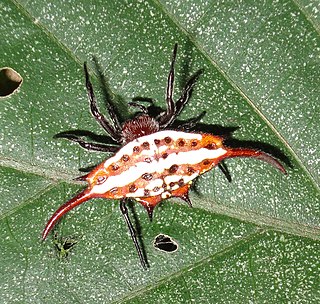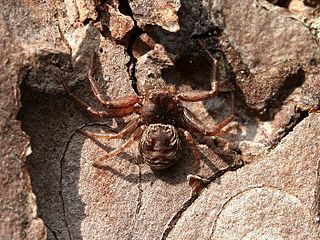
Spitting spiders (Scytodidae) is a family of araneomorph spiders first described by John Blackwall in 1864. It contains over 250 species in five genera, of which Scytodes is the best-known.

The Antilles pinktoe tarantula, also known as the Martinique red tree spider or the Martinique pinktoe, is popular as a pet spider because of its docile character and unique coloration.

Barychelidae, also known as brushed trapdoor spiders, is a spider family with about 300 species in 42 genera.

Ochyroceratidae is a six-eyed spider family, with 165 described species in ten genera. They are common inhabitants of caves and the tropical forest litter of South Africa, the Caribbean, Asia and South America. Considered an ecological counterpart of the Linyphiidae of the northern temperate zone, species are especially diverse in the Indo-Pacific region.

Cithaeronidae is a small family of araneomorph spiders first described by Simon in 1893 Female Cithaeron are about 5 to 7 millimetres long, males about 4 millimetres (0.16 in).

Symphytognathidae is a family of spiders with 90 described species in eight genera. They occur in the tropics of Central and South America and the Australian region. Exceptions include Anapistula benoiti, Anapistula caecula, and Symphytognatha imbulunga, found in Africa, Anapistula ishikawai, found in Japan, and Anapistula jerai, found in Southeast Asia.

Gasteracantha versicolor, known as the long-winged kite spider, is a species of diurnal spiny orb-weaver of the family Araneidae. It is found in the tropics and sub-tropics, where it occurs in forests. It has an extensive range, from central, east and southern Africa to Madagascar.

Coriarachne is a genus of crab spiders that was first described by Tamerlan Thorell in 1870. Over half of described species have been synonymized or moved to similar genera, including Bassaniana, Bassaniodes, and Pycnaxis.

Bassaniana, commonly called bark crab spiders, is a widespread genus of crab spiders that was first described by Embrik Strand in 1928.

Bassaniana decorata is a species of spider in the family Thomisidae, found in Russia, China, Korea and Japan.
Bassaniana ora is a species of spider in the genus Bassaniana, native to Korea.
Eburneana wandae is a species of jumping spider in the genus Eburneana that mimics ants. It was named by Tamás Szűts after the Polish arachnologist Wanda Wesołowska. The male of the species was first described in 2003, with the holotype found in the forests of central Africa. It is a relatively large spider, 8.2 millimetres (0.32 in) long, and is distinguished from the similar Eburneana scharffi by its different geography, being found in Cameroon rather than Tanzania, and the shape of the spider's front legs.
Eburneana scharffi is a species of jumping spider in the genus Eburneana that mimics ants. Found in Tanzania, the spider was first described in 2001. It is a large spider, particularly the male, with a carapace that is between 3.9 and 4.6 millimetres long, and shares features to both species in its own genus and those in the family Pelleninae. The female has a distinctive pattern on its abdomen formed by white hairs. It is the type species of the genus.
Eburneana magna is a species of jumping spider in the genus Eburneana that mimics ants. It is a large spider, as is emphasised by the species name, the Latin for big, with a body that can be up to 12 millimetres (0.47 in) in length, although only the female has been identified and in other species in the genus the male is larger than the female. The species has been identified from a holotype found in Ivory Coast.

Caribena is a genus of spiders in the family Theraphosidae (tarantulas), found in the Antilles. The two species accepted as of March 2017 were formerly placed in Avicularia. Apart from a different distribution – Avicularia species are found in mainland South and Central America – Caribena is distinguished by having longer and thinner type II urticating hairs in a conspicuous patch on the upper surface of the abdomen. Males also have a differently shaped palpal bulb.
Exechopsis is a genus of South American dwarf spiders that was first described by Alfred Frank Millidge in 1991. As of May 2019 it contains only three species: E. conspicua, E. eberhardi, and E. versicolor.
Hersiliola versicolor is a species of spiders of the family Hersiliidae that lives in Cape Verde. It was first described by John Blackwall in 1865 as Hersilia versicolor. The females have a total length of 3.75-4.58 mm.
Rhene pinguis is a species of jumping spider in the genus Rhene that was identified in South Africa. The male was first described in 2009 and the female in 2018. The spider is flat and hairy, its swollen look giving rise to its species name. The female is slightly larger than the male, but neither have been seen with a cephalothorax longer than 1.5 millimetres (0.059 in) and abdomen more than 2.0 millimetres (0.079 in) in length.
Pristobaeus taveuniensis is a jumping spider species in the genus Pristobaeus. The male was first identified in 2008 by Barbara Maria Patoleta. The species was initially placed in the genus Palpelius but was renamed Pristobaeus taveuniensis when Palpelius was accepted as the junior synonym for Pristobaeus.
Pristobaeus vanuaensis is a jumping spider species in the genus Pristobaeus. The female was first identified in 2008 by Barbara Maria Patoleta. The species was initially placed in the genus Palpelius but was renamed Pristobaeus vanuaensis when Palpelius was accepted as the junior synonym for Pristobaeus.











